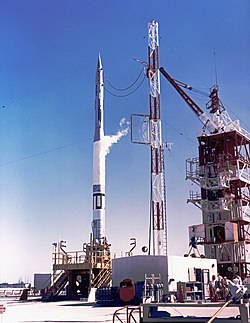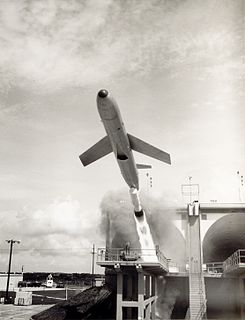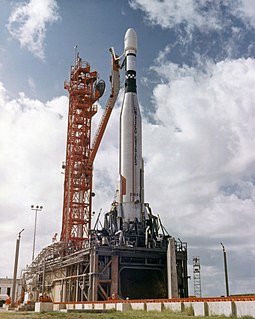
Launch Complex 39 (LC-39) is a rocket launch site at the John F. Kennedy Space Center on Merritt Island in Florida, United States. The site and its collection of facilities were originally built for the Apollo program, and later modified for the Space Shuttle program.

Cape Canaveral Air Force Station Launch Complex 34 (LC-34) is a launch site on Cape Canaveral, Florida. LC-34 and its companion LC-37 to the north were used by NASA from 1961 through 1968 to launch Saturn I and IB rockets as part of the Apollo program. It was the site of the Apollo 1 fire, which claimed the lives of astronauts Gus Grissom, Ed White, and Roger Chaffee on January 27, 1967.

Cape Canaveral Air Force Station Space Launch Complex 37 (SLC-37), previously Launch Complex 37 (LC-37), is a launch complex on Cape Canaveral, Florida. Construction began in 1959 and the site was accepted by NASA to support the Saturn I program in 1963. The complex consists of two launch pads. LC-37A has never been used, but LC-37B launched unmanned Saturn I flights and was modified and launched Saturn IB flights, including the first (unmanned) test of the Apollo Lunar Module in space. It was deactivated in 1972. In 2001 it was modified as the launch site for Delta IV, a launch system operated by United Launch Alliance.

Launch Complex 19 (LC-19) is a deactivated launch site on Cape Canaveral Air Force Station, Florida used by NASA to launch all of the Gemini manned spaceflights. It was also used by unmanned Titan I and Titan II missiles.

Cape Canaveral Air Force Station Space Launch Complex 41 (SLC-41), previously Launch Complex 41 (LC-41), is an active launch site at the north end of Cape Canaveral, Florida at Cape Canaveral Air Force Station. The site is currently used by United Launch Alliance (ULA) for Atlas V launches. Previously, it had been used by the Air Force, for Titan III and Titan IV launches. In the future, the pad will be used to launch the partly-reusable Vulcan launch vehicle. It is expected to launch for the first time in 2021.

Launch Complex 14 (LC-14) is a launch site at Cape Canaveral Air Force Station in Florida. LC-14 was used for various manned and unmanned Atlas launches, including the Friendship 7 flight aboard which John Glenn became the first American to orbit the Earth.

Launch Complex 5 (LC-5) was a launch site at Cape Canaveral Air Force Station, Florida used for various Redstone and Jupiter launches.

Launch Complex 36 (LC-36)—formerly known as Space Launch Complex 36 (SLC-36) from 1997 to 2010—is a launch complex at Cape Canaveral Air Force Station in Brevard County, Florida. It was used for Atlas launches by NASA and the US Air Force from 1962 until 2005.

Launch Complex 11 (LC-11) at Cape Canaveral Air Force Station, Florida, is a launch complex used by Atlas missiles between 1958 and 1964. It is the southernmost of the launch pads known as Missile Row. When it was built, it, along with complexes 12, 13 and 14, featured a more robust design than many contemporary pads, due to the greater power of the Atlas compared to other rockets of the time. It was larger, and featured a concrete launch pedestal that was 6 metres (20 ft) tall and a reinforced blockhouse. The rockets were delivered to the launch pad by a ramp on the southwest side of the launch pedestal.

Launch Complex 12 (LC-12) at Cape Canaveral Air Force Station, Florida was a launch pad used by Atlas rockets and missiles between 1958 and 1967. It was the second-most southern of the pads known as Missile Row, between LC-11 to the south and LC-13 to the north. Along with Complexes 11, 13 and 14, 12 featured a more robust design than many contemporary pads, due to the greater power of the Atlas compared to other rockets of the time. It was larger, and featured a concrete launch pedestal that was 6 metres (20 ft) tall and a reinforced blockhouse. The rockets were delivered to the launch pad by means of a ramp on the southwest side of the launch pedestal.
Launch Complex 15 (LC-15) at Cape Canaveral Air Force Station, Florida is a deactivated launch complex used by LGM-25 Titan missiles between 1959 and 1964. It was originally built for conducting test flights of the Titan I, which made its maiden flight from LC-15 on 6 February 1959. LC-15 is the southernmost of the four original Titan launch complexes on Missile Row.

Launch Complex 16 (LC-16) at Cape Canaveral Air Force Station, Florida is a launch complex built for use by LGM-25 Titan missiles, and later used for NASA operations before being transferred back to the US military and used for tests of MGM-31 Pershing missiles. Six Titan I missiles were launched from the complex between December 1959 and May 1960. These were followed by seven Titan II missiles, starting with the type's maiden flight on March 16, 1962. The last Titan II launch from LC-16 was conducted on May 29, 1963.

Launch Complex 18 (LC-18) is a launch complex at the Cape Canaveral Air Force Station, Florida that was active during the late 1950s and early 1960s. It was used by Viking, Vanguard, Thor and Scout rockets. The complex consists of two launch pads, LC-18A, which was originally built by the US Navy for the Vanguard rocket, and LC-18B, which was originally by the US Air Force used for tests of the PGM-17 Thor missile.

Launch Complex 31 (LC-31) is a former launch complex at Cape Canaveral Air Force Station, Florida.

Launch Complex 21 (LC-21) at Cape Canaveral Air Force Station, Florida is a launch complex that was used for horizontal launches of cruise missiles between 1958 and 1963. It initially consisted of a single launch rail, from which XSM-73 Bull Goose missiles were tested. Between 1959 and 1960, the complex was rebuilt for the MGM-13 Mace, with a second rail added, and a large concrete structure erected around the launch rails, earning the pad the nickname of "the hardsite".
Launch Complex 22 (LC-22) at Cape Canaveral Air Force Station, Florida is a launch complex that was used for horizontal launches of cruise missiles between 1957 and 1960. It consisted of two launch rails, from which XSM-73 Bull Goose and MGM-13 Mace missiles were tested. Unlike the other Mace launch site, Launch Complex 21, no concrete structure was built to enclose the launch rails when it was converted to launch the Mace in 1959. This earned the pad the nickname of "the softsite".
Launch Complex 32 (LC-32) is a former launch complex at Cape Canaveral Air Force Station, Florida.
Launch Complex 25 (LC-25) was a four-pad launch site at Cape Canaveral Air Force Station, Florida built for test flights of the US Navy's submarine-launched ballistic missiles Polaris, Poseidon and Trident from 1958–1979.














